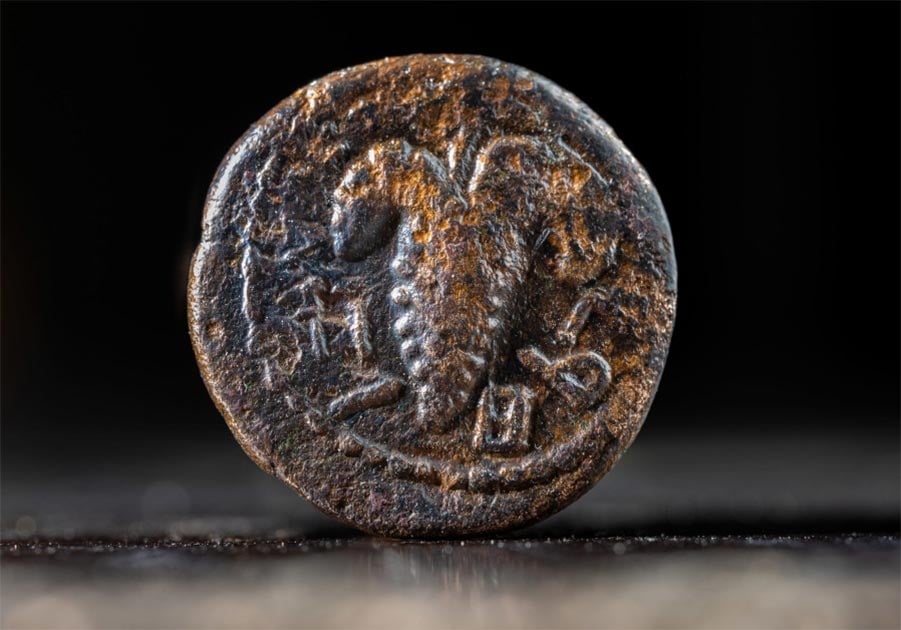Ancient Coin of Jewish Bar-Kokhba Rebellion Against Rome Unearthed
In Jerusalem, archaeologists have unearthed a very rare find. They have revealed a coin that was issued by Jewish rebels against Roman rule from the 2 nd century AD. It was minted by the last Jewish independent state before the establishment of Israel. This find is unique because of its inscription, where it was found and from what it was made.
The discovery was made by archaeologists working with the Israel Antiquity Authority (IAA). It was found in the William Davidson Archaeology Park in the Jewish Quarter of the Old City of Jerusalem. Based on the inscriptions the experts were able to establish that it dates to the Bar-Kokhba rebellion (132-136 AD). Donald Tzvi Ariel, who works with the IAA told The Jerusalem Post that ‘out of 22,000 coins found in the Old City, only four can be traced back to the Bar-Kokhba’. It is the first time in 40 years that money of this type has been found in the area.

The Western Wall at the Davidson Center - Jerusalem Archaeological Park, Jerusalem. (Deror_avi / CC BY-SA 3.0)
Last great Jewish rebellion against Rome
The Bar-Kokhba Rebellion (132-136 AD), was the third great war against the Romans. The other two were the Kitios War (115-117) and the First Jewish War (66-70 AD). This was led by Simeon Bar-Kokhba, (Son of a Star) a charismatic leader, who many regarded as the Messiah, foretold in the Book of Numbers in the Old Testament. The rebellion began after Emperor Hadrian ordered the construction of a pagan temple in Jerusalem which many Jews saw as sacrilege. In the beginning, the revolt caught the Roman occupiers by surprise and the revolt saw some successes. Simon and his followers build strongholds in the mountains and waged a guerrilla war against the Romans and they managed to create a small independent state.
It appears that there were efforts to ‘re-establish sacrificial worship’ under the High Priest Eleazar, according to My Jewish Learning. However, the Romans launched a scorched earth campaign, 100s of cities, towns and villages being destroyed and ultimately the collapse of the rebellion. Many Jews were killed and driven into exile and Jerusalem became a Roman colony and even its name was changed. The next time that there would be an independent Jewish state would be in 1948, with the creation of the state of Israel.
- Hiker Finds Extremely Rare Gold Coin in Israel
- 1,600-Year-Old Mosaic with Rare Blessing Inscription Gives Insight into the Samaritans
- Cave of Zedekiah: The Secret Grotto of Jerusalem

Arthur Szyk,1927, Bar-Kokhba, watercolor and gouache on paper. (CC BY-SA 4.0)
Coin and the freedom of Israel
Hamodia reports that the bronze coin bears the inscription ‘year two of the freedom of Israel’. It is decorated with a cluster of grapes on the obverse side. The rebels produced many similar coins with Jewish symbolism but this one has some slightly different motifs. It appears that this money was used to pay taxes in the territories controlled by the Jews.
Most important of all it bears the inscription ‘Jerusalem’ in Hebrew. This coin makes clear the rebels’ ambitions to seize Jerusalem. Ariel is quoted by the Jerusalem Post as saying that ‘Jerusalem was the goal and the battle-cry of the Bar-Kokhba rebels’. This was because it contained many holy sites and was the traditional capital of the Jewish kingdom, but the rebels never did manage to conquer the city.

Bar Kokhba Revolt Coin inscribed with the word "Jerusalem" and a picture of a date palm. (Koby Harati/City of David/Israel Antiquities Authority)
Rebel propaganda
Hamodia notes the rebels reused Roman coins ‘with stripped or damaged faces’ and this was possibly out of defiance of the Imperial authorities. This find also demonstrates that coins were used by the rebels for propaganda. Ariel told The Jerusalem Post that by issuing such coins the rebels were ‘definitely stating that ‘we are here, an independent nation from the Romans’. Because they would have been used in many transactions they were a great way of helping the rebels to get their message across to the people and inspired more of the population to join them in their struggle.
There is one mystery about the bronze artifact and that is how did it get there. The rebels did not conquer the city after all. Israel Hayom reports that IAA archaeologists speculate that a Roman legionnaire ‘found the coin during one of the battles across the country and brought it to their camp in Jerusalem as a souvenir’. It may have been found on the body of a dead insurgent.
Celebration of Lag Ba’ Omer
The coin was presented as part of the celebrations of Lag Ba’ Omer, which commemorates the ‘life of anti-Roman Torah sage Rabbi Shimon Bar Yochi’ according to Israel Hayom. This day has also traditionally commemorated the Bar-Kokhba rebellion. It also celebrates the day when a great plague that had been killing rabbinical students miraculously ceased. The coin offers a unique insight into the last great Jewish revolt against Roman rule, which is still revered to this day in Israel.
Top image: Bar-Kokhba Rebellion coin inscribed with the words "Return to Israel" with a cluster of grapes in the center. Source: (Koby Harati/City of David/Israel Antiquities Authority)
By Ed Whelan




















Comments
Russolim is one of the branch cities of ancient Russia, which is Ukraine, not Muscovy. Romania is one of the ancient Aryan states of Russia-Ukraine. The whole story is the story of the penetration of Satanists into the Arian states from within. Jerusalem was never Jewish, as was Moscow by Russia.